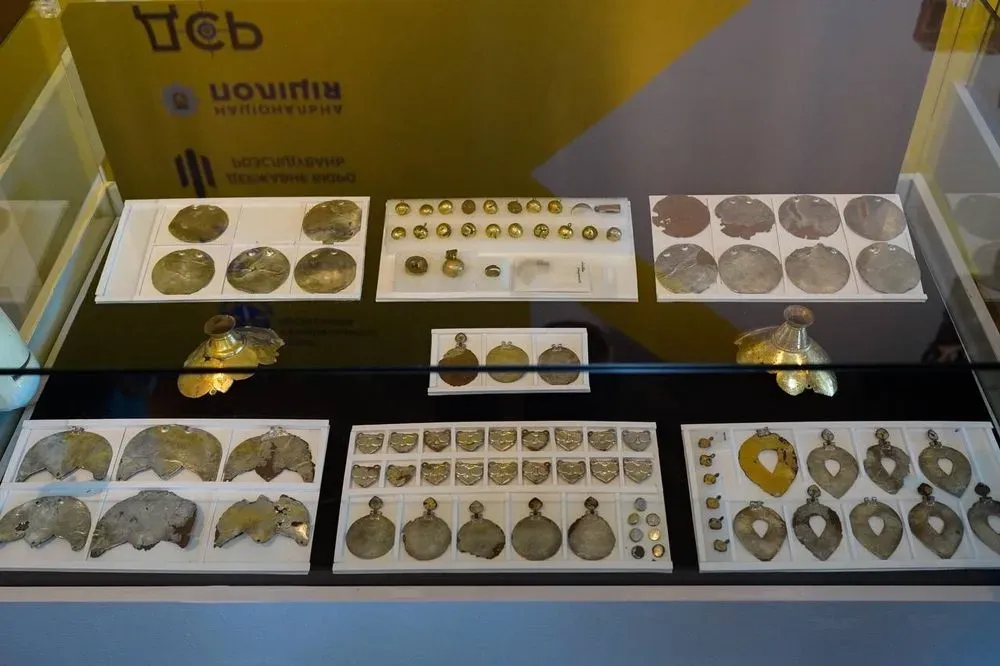Estonia returns almost three hundred Ukrainian artifacts: rare ancient coins and jewelry
Kyiv • UNN
Estonia has returned 274 illegally exported archaeological artifacts to Ukraine, including ancient Scythian, Sarmatian and medieval jewelry, coins and horse harness, demonstrating support for Ukraine's cultural heritage during the ongoing war.

Estonia has returned 274 cultural heritage items illegally exported by smugglers to Ukraine. Among the returned valuables are coins and objects found during aerial excavations. This was reported by the Ministry of Culture and Information Policy, UNN reports.
The National Museum of History of Ukraine presented 274 archeological items, including 115 coins that had previously been illegally exported from Ukraine. They were detained when smugglers tried to cross the border. Estonian border guards and the Republic of Estonia returned them to Ukraine.
Details
Among the returned artifacts:
- jewelry of the Scythian period: two paired patch plaques in the form of griffins, IV-III centuries BC; a shroud, probably of a wooden vessel or horn, IV-III centuries BC Analogues are known from numerous "royal" burials from the territory of Ukraine - the mounds of Tovsta Mohyla, Solokha, and Haymanova Mohyla
- jewelry of the pre-Roman and Roman periods: amulet holders in the form of cylinders and beads, first century BC - first century AD Similar jewelry is known from Eastern Crimea (Bosporus Kingdom); gold beads, 1st century Characteristic of the burials of Sarmatian nobility, for example, Nogaychyn barrow on the territory of the temporarily occupied Crimea. Jewelry, including almandines, and a paste insert in the form of a scarab, 1st-3rd c. Similar jewelry is known from Sarmatian burials and dirt cemeteries in the Western Crimea (early horizons of the Ust-Alma, Neizats cemeteries, etc.). In recent years, Moscow archaeologists have been conducting numerous illegal excavations on the territory of the temporarily occupied Crimea. Similar decorations were found in the early burials of the Frontovoe cemetery near Sevastopol.
- medieval finds: a ceremonial horse harness, turn of the VIII-IX centuries - beginning of the IX century. Such a horse harness is known from burials with horses of the Saltovo-Mayak culture, which is associated with the Khazars. However, jewelry of this level has been found only on the territory of Ukraine - burial No. 482 of the Netailiv cemetery and 8 burials of the Verkhnii Saltiv cemetery (Kharkiv region). A ring with a bird holding a laurel branch in its paws, tenth to twelfth centuries. A typical medieval ring with a Byzantine theme, known from many similar finds at medieval sites in Ukraine (Kyiv, Chernihiv, etc.).
- coins of Byzantine emperors: Constantine VII Porphyrogenitus (920-944), Nikephoros 11 Phocas (963-969); John I Cimischius (969-976), Basil II Bulgarobius (976-1025). Similar coins in the tenth and eleventh centuries were widespread almost throughout the territory of modern Ukraine.
Now the entire civilized world, which respects international law and is rooting for the victory of our country, as well as for justice to prevail not only in defending the independence of the territories, but also in the legality of the movement of cultural property, is with Ukraine.
When handing over the valuables to the Ukrainian side, the acting Minister also emphasized that Ukraine greatly appreciates the support of the Estonian people. He also noted that Estonia is also helping to restore facilities in the Zhytomyr region, which was actually taken under patronage by Estonian colleagues. In addition, in the first months of the full-scale war, it was from Estonia that cargoes with everything Ukrainian museums needed - equipment and packaging materials for the evacuation of cultural property - were sent.
Estonia has supported, supports and will continue to support Ukraine in all areas-politically, economically, militarily, as long as it is needed. Today, I am very pleased to see our closer cooperation in the cultural sphere, despite the ongoing war. Today is a historic day. The artifacts belonging to Ukraine have finally returned home. These artifacts - are a testament to Ukrainian culture and identity and are Ukrainian heritage.







